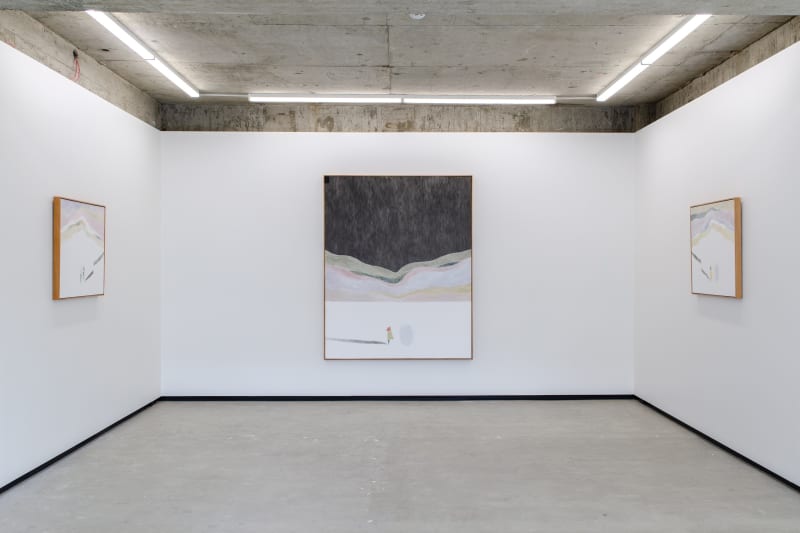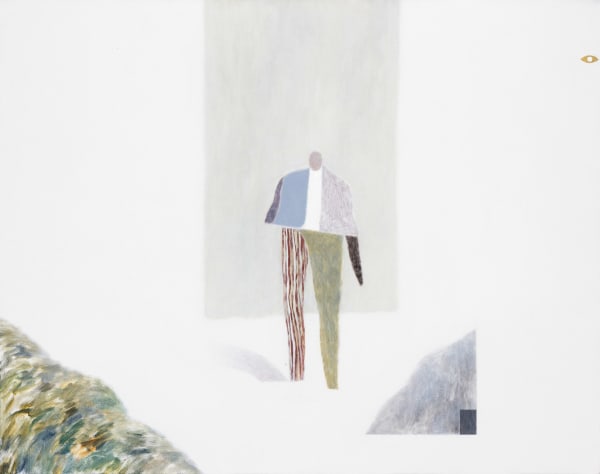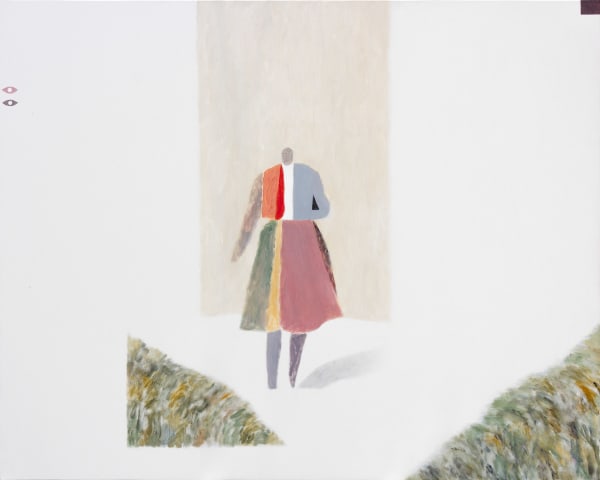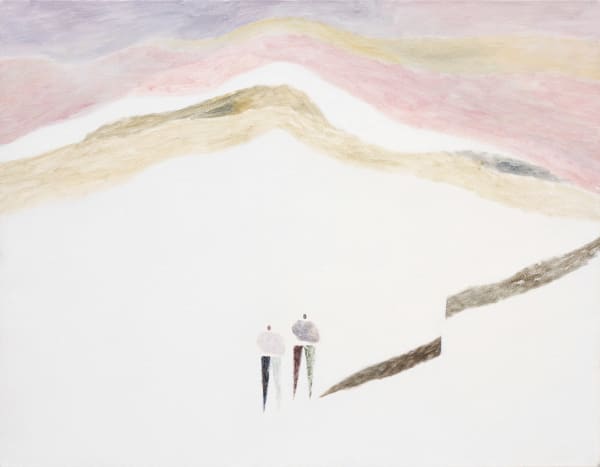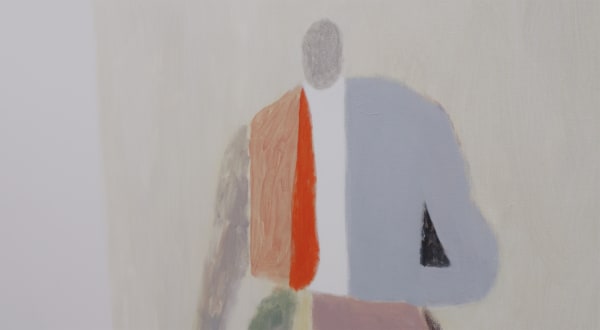Alan Ibell, A New Mountain
We are pleased to present a solo exhibition of new paintings by Alan Ibell, A New Mountain.
The works in A New Mountain explore ideas of knowledge and self-knowledge by excavating the image of the mountain as a site of enlightenment. Well-established in scriptural and mythological narratives as a location of divine wisdom, mountains are here invoked to question whether such wisdom is obtainable or even desirable in today’s world.
Alan’s regular motifs, the landscape, the portal, the vessel, and the figure – along with its fractured shadow, all resurface in this grand new suite of paintings — perhaps Alan’s most ambitious works to date. The scale allows us to immerse ourselves in the seductive and contemplative qualities of his brushwork and expanse of landscape.
In the work that lends the exhibition its name (the largest Alan has ever painted) a lone figure stands on a stark plateau, her shadow disproportionate as she peers into a clouded mirror or perhaps a portal, waiting for its opacity to resolve. Behind her looms the familiar mountainous landscape, except that something is different, ‘new’ about it. The expanse of black filling the top half of the canvas suggests a starless sky, a void, or an emblem of the unconscious.
A New Mountain furthers Ibell’s longstanding interest in the correspondence and conflict between the inner and outer facets of the self. As the viewer moves from work to work, each canvas is at times dominated by a figure and at times by the landscape, suggesting the constant tussle between ego and id, and the fragility of the narratives we construct about our place in the world.
A text by Hannah August and a video by Fraser Walker will accompany the exhibition.
A New Mountain
In the work that lends Alan Ibell’s exhibition its name, a lone figure stands on a stark plateau, her shadow disproportionate as she peers into a clouded mirror or perhaps a portal, waiting for its opacity to resolve. Behind her looms the mountainous landscape familiar from other recent works by Ibell, except that something is different, ‘new’ about it. The mountains whose slopes have previously dwarfed the figures below them are inverted — transformed not into valleys but into a mirror image of the peaks of The Returned. The viewer is led deliberately to a place of doubt and uncertainty: the landscape that appeared straightforwardly silhouetted against a night sky now appears metaphorical, a symbol of the confusion that can be generated in the quest for clarity and enlightenment. The expanse of black filling the top half of the canvas is no longer just a starless sky, but an emblem of the unconscious.
The risks and rewards of skewed perception are among Ibell’s abiding interests as an artist, and the works in A New Mountain explore ideas of knowledge and self-knowledge by excavating the image of the mountain as a site of enlightenment. Well-established in scriptural and mythological narratives as a location of divine wisdom, mountains are here invoked to question whether such wisdom is obtainable or even desirable in today’s world, and whether a quest for authentic self-realisation inevitably devolves into cynicism and ironic self-presentation.
In The Returned I and II the figures have returned from a pilgrimage to the top of the mountain, and now pause to consider how this pilgrimage has changed them. The double figures in The Returned II suggest that, rather than offering clarity and self-knowledge, the self has been split in two and the figures are each other’s doppelgänger, their shared shadow fragmented by the frustrated quest for unity. In The Returned I, the figure’s shadow is once more fragmented, suggesting a fractured inner self, and the mirror or portal upon which this ‘returned’ figure gazes is no less opaque than that in A New Mountain.
The repetition between works of visual motifs such as the mirror/portal, the female figure, or the schematic eye serves not only to situate the works within the same psycho-spatial world, but to foreground the fine line between the absurdity and profundity of patterns. This line is deliberately invoked by the titles of the works She came down from the mountain with a piece of the mountain to build a new mountain and He came down from the mountain with a piece of the mountain to build a new mountain, where the repetition of the word ‘mountain’ comes to seem both significant and inane.
The works themselves cement the performative nature of the task described by the titles — as soon as one metaphorical mountain is conquered, another must be confronted, often of one’s own making. This confrontation is signalled by the positioning of the figures, who — unusually in Ibell’s oeuvre — stare directly out at the viewer, hinting that it is the fact of being constantly observed that constitutes one mountain to be conquered. At the same time, the possibility of an authentic, unselfconscious mode of existence is thrown into doubt by the works’ composition, which, as in many of Ibell’s earlier paintings, is almost scenographic, suggesting that the figures inhabit a stage set rather than a ‘real life’.
The show’s larger works thus explore ideas of perception, self-perception and memory, asking whether we can ever truly be changed by an experience or if we are fated to live through variations on a theme (rendering Ibell’s repeated motifs a tongue-in-cheek commentary on this question). The two smaller works, Feedback Loop I and Feedback Loop II, offer a further perspective, with their titles gesturing towards the repetitious, cyclical nature of existence. The paintings themselves offer the viewer a chance to participate in the frustrated quest for enlightenment of the figures in the other works: according to the artist, one vessel is empty and one is full, waiting to be poured into the adjacent container. But the representational limits of the canvas occlude which is which, endlessly deferring a deliberately mundane revelation.
Taken as a whole, A New Mountain furthers Ibell’s longstanding interest in the correspondence and conflict between the inner and outer facets of the self. As the viewer moves from work to work, each canvas is at times dominated by a figure and at times by the landscape, suggesting the constant tussle between ego and id and the fragility of the narratives we construct about our place in the world. It speaks to a similar duality that it is the viewer, ultimately, who (through the motif of the hovering eye) is invited to ‘place’ these paintings and, in the act of looking, to impose a narrative upon them. On the one hand, the artist’s acknowledgement that subjective perception trumps creative intent can be read as cynical and defeatist. On the other hand, the explicit invitation to participate in the interpretation of the works can be seen as a playful and generous invitation to co-create – an offer not of the putative wisdom at the top of the mountain, but the chance to celebrate the fractured perception of multiple consciousnesses.
Hannah August

